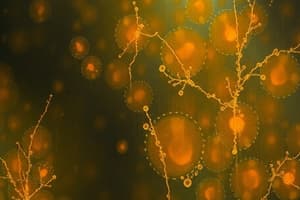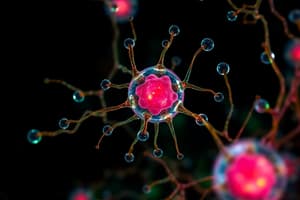Podcast
Questions and Answers
How does the structure of root cells enhance their function in nutrient absorption?
How does the structure of root cells enhance their function in nutrient absorption?
- Irregular shape for maximizing space
- Short and thick shape for faster absorption
- Dense cell walls to retain nutrients
- Long thin shape to increase surface area (correct)
What function do nerve cells perform that distinguishes them from other cell types?
What function do nerve cells perform that distinguishes them from other cell types?
- They are responsible for muscle contraction
- They can receive and send electrical signals (correct)
- They contribute to the immune response
- They can photosynthesize light
Which aspect of sperm cells is crucial for their role in fertilization?
Which aspect of sperm cells is crucial for their role in fertilization?
- Large cell body for storing energy
- Ability to absorb excess nutrients
- Presence of multiple tails for propulsion
- Head structure that carries genetic material (correct)
How are photosynthetic cells specialized for their function in capturing light?
How are photosynthetic cells specialized for their function in capturing light?
What is true about totipotent stem cells?
What is true about totipotent stem cells?
What characterizes totipotent stem cells?
What characterizes totipotent stem cells?
What is the primary role of pluripotent stem cells?
What is the primary role of pluripotent stem cells?
Which statement about multipotent stem cells is true?
Which statement about multipotent stem cells is true?
What is the correct order of cell organization in multicellular organisms?
What is the correct order of cell organization in multicellular organisms?
At what stage do embryonic stem cells exhibit their capability for self-renewal?
At what stage do embryonic stem cells exhibit their capability for self-renewal?
Why are stem cells important for multicellular organisms?
Why are stem cells important for multicellular organisms?
What is the main difference between adult stem cells and embryonic stem cells?
What is the main difference between adult stem cells and embryonic stem cells?
Which of the following correctly identifies a characteristic of unipotent stem cells?
Which of the following correctly identifies a characteristic of unipotent stem cells?
Flashcards are hidden until you start studying
Study Notes
Stem Cell Potency
- Potency: A cell's ability to differentiate into other cell types. The more types, the greater its potency.
- Totipotent Stem Cells: Found from zygote to the morula stage (16 cells), capable of becoming any cell type, including placental cells.
- Pluripotent Stem Cells: Present in blastocysts, can develop into any cell type within the body, but not placental cells.
- Multipotent Stem Cells: Found in adult tissues, can differentiate into a limited number of cell types within their tissue of origin.
- Unipotent Stem Cells: Can only differentiate into one specific cell type.
Cellular Differentiation
- Multicellular organisms begin with a single cell, the zygote, which divides and differentiates into trillions of specialized cells through mitosis.
- Cellular differentiation involves changes in gene expression within stem cells, leading them to become specialized.
- Stem cells are found in embryos, specific adult tissues, and meristem tissue in plants.
- Stem cells can divide indefinitely, while specialized cells have reduced or arrested division.
- Specialized cells can resume division to repair injuries or replace dead cells.
Cell Hierarchy
- Cellular differentiation allows multicellular organisms to function through a hierarchical organization.
- Specialized Cells: Individual cells with specific functions.
- Tissues: Groups of specialized cells working together to form a functional unit.
- Organs: Groups of two or more tissues working together for a common purpose.
- Systems: Groups of organs working together to perform a vital task.
- This hierarchical organization enables multicellular organisms to:
- Obtain nutrients
- Exchange gases
- Remove wastes
Stem Cells
- Two main types:
- Embryonic stem cells: Undifferentiated cells in embryos that can replicate indefinitely.
- Adult stem cells: Found in small numbers in adult tissues, have limited potential and cannot replicate indefinitely.
Specialised Cell Examples
- Root Hair Cell:
- Function: Absorb water and nutrients from the soil, increase surface area for absorption.
- Specializations: Long, thin shape, large surface area for increased absorption.
- Nerve Cell:
- Function: Transmit information in the nervous system.
- Specializations: Receive and send electrical signals, release neurotransmitters, respond to neurotransmitters, process and store information.
- Sperm Cell:
- Function: Responsible for fertilizing an egg cell during reproduction.
- Specializations: Head carries genetic material and helps break down the egg during fertilization, tail propels itself.
- Plant Leaf Cell:
- Function: Photosynthesis and light absorption.
- Specializations: Numerous chloroplasts for high chlorophyll concentration, large surface area to absorb water and minerals.
Studying That Suits You
Use AI to generate personalized quizzes and flashcards to suit your learning preferences.




